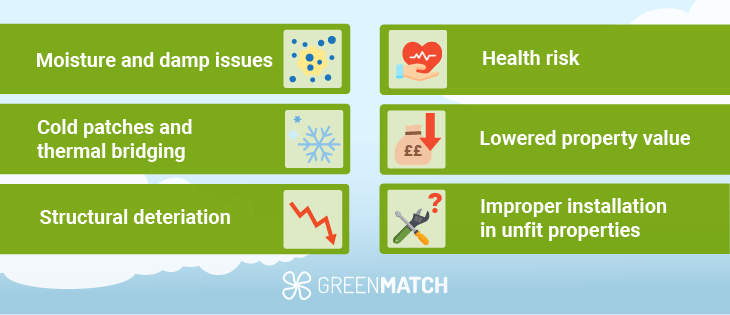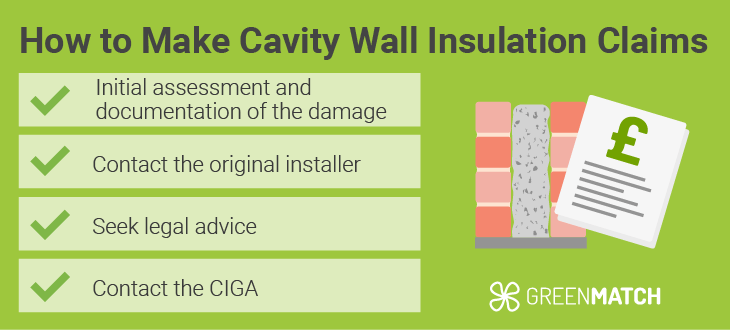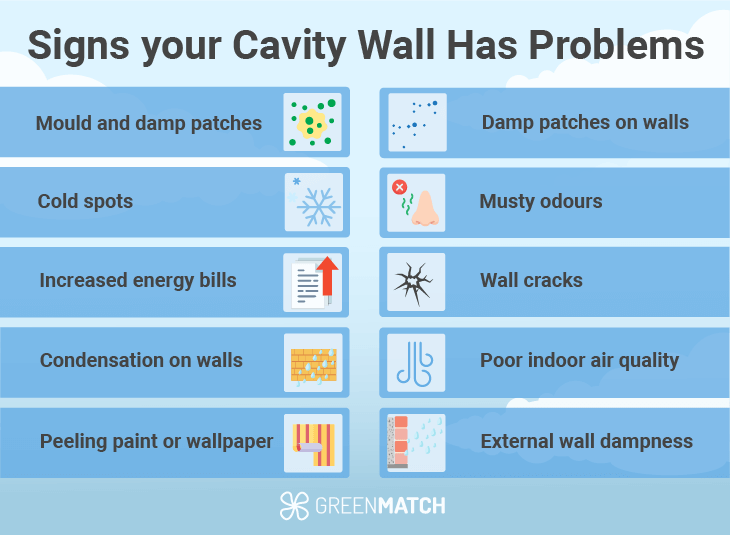Answer these simple questions and we will find you the BEST prices
Which type of solar quotes do you need?
It only takes 30 seconds
100% free with no obligation

Get Free quotes from insulation specialists near you

Save money by comparing quotes and choosing the most competitive offer

The service is 100% free and with no obligation
- GreenMatch
- Insulation
- Wall Insulation
- Cavity Wall Insulation
- Government Cavity Wall Insulation
Government Cavity Wall Insulation: The Problem-Solving Guide


- Uninsulated walls cause up to 33% of all heat loss in a home.
- Government-funded programs have come under fire for poor installation practices that compromise the effectiveness of insulation.
Cavity wall insulation is a highly effective upgrade that improves your home's energy efficiency. By minimising heat loss through walls, cavity wall insulation lowers energy bills and creates a more comfortable living environment, making your house a cosy refuge from the elements.
However, despite its numerous benefits, cavity wall insulation has met challenges and issues, particularly in installations carried out under government schemes.
Are you looking to insulate your home? Let GreenMatch do the hard work for you. Say goodbye to tedious research and scheduling. Please fill out our quick 30-second form online and get up to 3 free quotes from reliable installers near you. Click below to begin now!
- Describe your needs
- Get free quotes
- Choose the best offer
It only takes 30 seconds



What are the government cavity wall insulation problems?

Cavity wall insulation unquestionably delivers numerous benefits, such as significantly improved energy efficiency, substantial reductions in utility bills, and a marked increase in property comfort. Government grant schemes Energy Company Obligation (ECO4) and Great British Insulation Scheme (GBIS) have intensified the demand for cavity wall insulation, driven by the clear objective of meeting sustainability goals and reducing carbon footprints.
Yet, this rise in demand has sometimes led to subpar installation practices due to the pressure on cavity wall insulation installers to work quickly. Therefore, there have been several issues:
- Moisture and damp issues: Insulation not appropriately installed can trap moisture in the walls, causing mould to grow. This can damage property and lead to respiratory problems and allergic reactions.
- Cold patches and thermal bridging: Uneven distribution of insulation or gaps can result in thermal bridging, giving uneven heating in the home. Specific areas stay cold despite the heating system working effectively, potentially leading to higher heating costs instead of reducing them.
- Structural deterioration: Excessive moisture trapped between walls can weaken the structure, creating cracks and other damage. In severe cases, this can even compromise the integrity of the building. Continuous exposure to moisture can degrade building materials, such as wood and plaster, resulting in costly repairs and renovations.
- Health risks: Mould spores and damp conditions can bring respiratory issues, especially in people with asthma or allergies.
- Lowered property value: Damp patches, mould growth, and structural damage can affect a property's appeal and decrease its market value. The expense and effort needed to fix insulation problems may discourage potential buyers, reducing the property's value.
- Improper installation in unfit properties: Older homes with solid walls or those in exposed areas may not be suitable for cavity wall insulation. In these instances, insulation may worsen existing issues or give rise to new ones. Cavity wall insulation can disrupt natural ventilation in older buildings, creating moisture accumulation and associated problems.
Who can make a claim for cavity wall insulation problems
Homeowners who experience issues with their cavity wall insulation may be eligible to claim compensation or remediation, provided they meet specific criteria.
Firstly, the claimant must be the property owner where the cavity wall insulation was installed, as tenants or non-owners are generally not eligible. Unfortunately, due to the Limitation Act of 1980, it is impossible to claim if your insulation was fitted more than 15 years ago. This is because you have limited time to legally take out a claim against a defendant. The insulation must have been installed within the last 15 years, as claims for older installations normally fall outside the warranty or guarantee periods, which usually extend to a maximum of 15 years.
How to make cavity wall insulation claims

To make a claim, you must provide evidence of improper installation practices or defects in the insulation material.
How to make a claim against the installer
The homeowner must prove that the poor installation has hurt their property, such as physical damage, reduced energy efficiency, increased energy bills, or health issues arising from mould and dampness. Prompt reporting of issues and maintaining detailed records of all communications with the installer or relevant authorities is crucial.
The claims process begins with an initial assessment and documentation of the damage, followed by contacting the original installer to seek remediation. If the installer is unresponsive or fails to resolve the issue satisfactorily, the claim can be escalated to the relevant guarantee agency.
In more complex cases, seeking legal advice might be necessary, and homeowners can also approach government or consumer protection associations for additional support. Proper documentation and following the correct procedures can raise the chances of a successful claim for cavity wall insulation problems.
The installation should have been carried out by a company or contractor accredited by a recognized body, the Cavity Insulation Guarantee Agency (CIGA) in the UK, as claims are often only valid if the work was covered under a relevant guarantee scheme.
How to make a claim from CIGA
Making a claim from the Cavity Insulation Guarantee Agency (CIGA) for issues with your cavity wall insulation involves several steps to address your concerns efficiently.
If the installer is unresponsive or unable to resolve the problem, escalate the matter to CIGA by contacting their customer service department through phone, email, or website. You will need to complete a claim form, which can be downloaded from CIGA's website or obtained from their customer service, and provide accurate details about your property, the installation, and the issues you are experiencing, along with all relevant documentation. CIGA will then arrange for an independent inspector to visit your property and assess the problems reported.
Based on the inspector's report, CIGA will determine whether the problems fall under the guarantee terms and if remedial action is required. If your claim is approved, CIGA will organise the necessary remedial work, which could involve repairs, additional insulation, or complete reinstallation.
After the remedial work is completed, inspect your property to ensure that the issues have been resolved, maintaining communication with CIGA and the contractor to address any further concerns.
Signs your cavity wall insulation has problems

If your cavity wall insulation has been improperly installed or is faulty, you must be aware of signs that may indicate problems. Recognizing these signs early can help you take action to address issues before they deteriorate. Here are some common indicators of improper cavity wall insulation:
- Damp patches on walls
- Mould growth
- Cold spots
- Increased energy bills
- Condensation on walls
- Peeling paint or wallpaper
- Musty odours
- Wall cracks
- Health issues
- Poor indoor air quality
- External wall dampness
Essential checks to avoid problems before committing to cavity wall insulation
Before proceeding with cavity wall insulation, it's important to complete some essential checks to ensure your home is suitable and prevent potential issues:
Suitability of your walls
Check to see if your walls are suitable for cavity wall insulation. Homes with solid walls or properties built before the 1920s might not be ideal candidates. Inspect your walls for structural damage, like cracks or holes, and solve these issues before installation to prevent aggravating existing problems.
Climate
Living in an area prone to wind-driven rain greatly increases the risk of moisture penetration into your home. Enforcing extra precautions or alternative insulation methods is crucial.
The existing condition of the walls
Inspect any existing mould or dampness thoroughly. Failing to resolve these issues beforehand can worsen the problem, potentially bringing bigger damage in the long run.
Ventilation
Assure that your home has proper ventilation to prevent moisture build-up, which can cause mould and damp issues after installation.
Installer qualifications
When considering an installer for a project, choosing a qualified and accredited professional is important. You should verify their credentials and confirm they are registered with recognized bodies, such as the Cavity Insulation Guarantee Agency (CIGA). Verifying that the installer offers a guarantee or warranty for their work is also crucial. Requesting references from the installer's previous clients and reviewing online feedback can provide great insights into their reputation and the quality of their work.
Regulations and permissions
Make sure that the installation meets local building regulations. Request any necessary permissions if required.
Aftercare service
Verify if the installer provides aftercare services for maintenance and addresses any issues after the installation.
Professional assessment
A professional surveyor is advised to assess your property. They can provide expert advice on suitability and potential issues and recommend the best insulation options for your home.
Performing these essential home insulation checks is important to make an informed decision and guarantee a successful cavity wall insulation installation that will improve your home's energy efficiency and comfort.
Are you considering insulating your home? Let GreenMatch handle the hard work for you. Skip the hours of online research and appointment scheduling – fill out our quick online form in 30 seconds. You'll then receive up to 3 free quotes from vetted installers near you. Take the first step now by clicking the button below!
- Describe your needs
- Get free quotes
- Choose the best offer
It only takes 30 seconds



FAQ
If your cavity wall insulation was installed under a guarantee like CIGA (Cavity Insulation Guarantee Agency) and has failed, you qualify for free removal and remediation. Contact CIGA or review your home insurance policy for coverage options.
You can claim warranties or consumer rights if your insulation fails to meet standards or causes issues. Begin by contacting the installer, and if necessary, escalate the matter to CIGA or consumer protection agencies. For complex disputes, asking for legal advice may be essential.
Look for damp patches, mould growth, cold spots, increased bills, or condensation. These signs could signal potential insulation problems. It’s important to ask for professional inspection and advice without delay.
Since 2008, more than three million homes have undergone cavity wall insulation installations as part of government-backed green energy programs. To guarantee quality, energy suppliers were assigned to inspect 5% of these installations. However, a scandal has brought to light widespread issues stemming from poorly executed cavity wall insulation, resulting in dampness, mould, and various forms of damage.

Akif is a copywriter at GreenMatch since 2023. With a keen interest in community sustainability, green solutions and the role of digital media in identifying climate trends, he aims to hone in on his background in International Studies and Digital Media to provide a multidisciplinary approach to written content rooted in credible research and accuracy.
We strive to connect our customers with the right product and supplier. Would you like to be part of GreenMatch?

- Government Cavity Wall Insulation: The Problem-Solving Guide
- What are the government cavity wall insulation problems?
- Who can make claim for cavity wall insulation problems
- How to make cavity wall insulation claims
- Signs your cavity wall insulation has problems
- Essential checks to avoid problems before committing to cavity wall insulation
- FAQ
